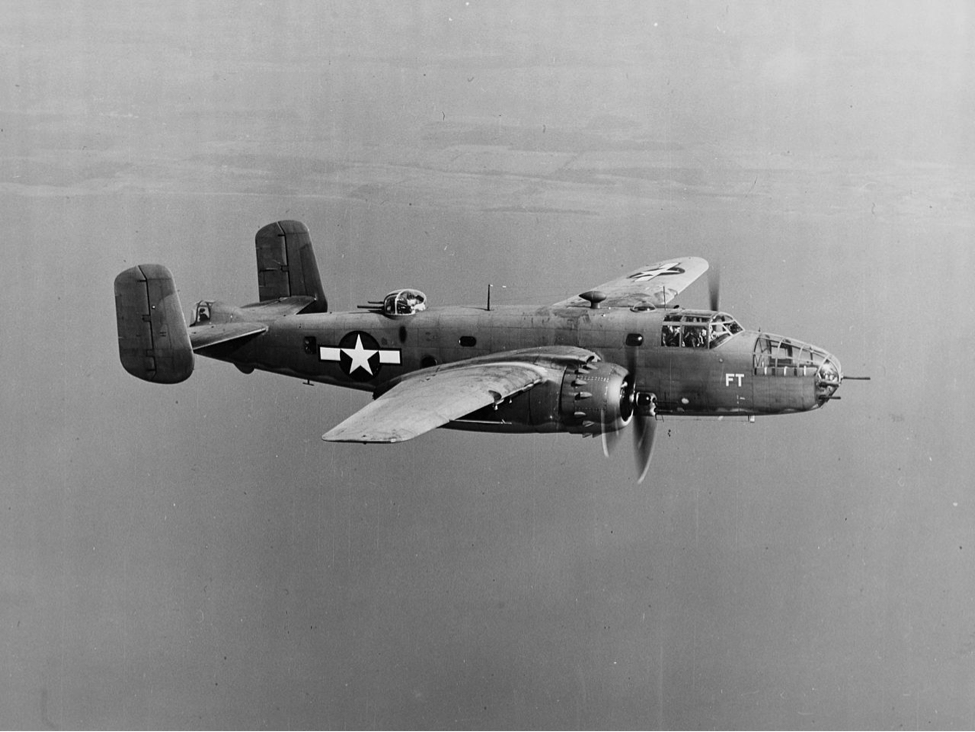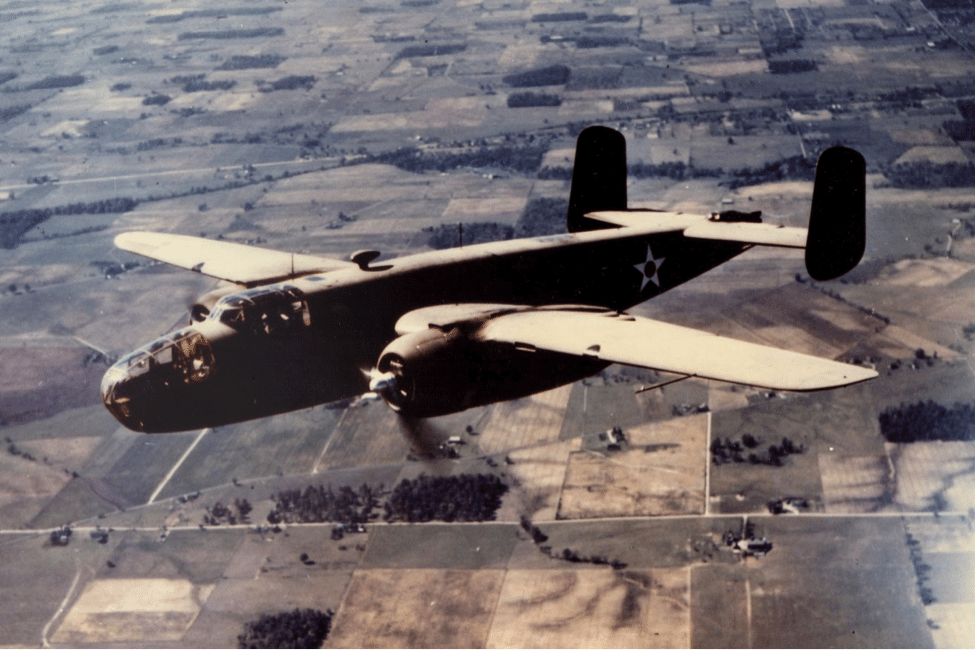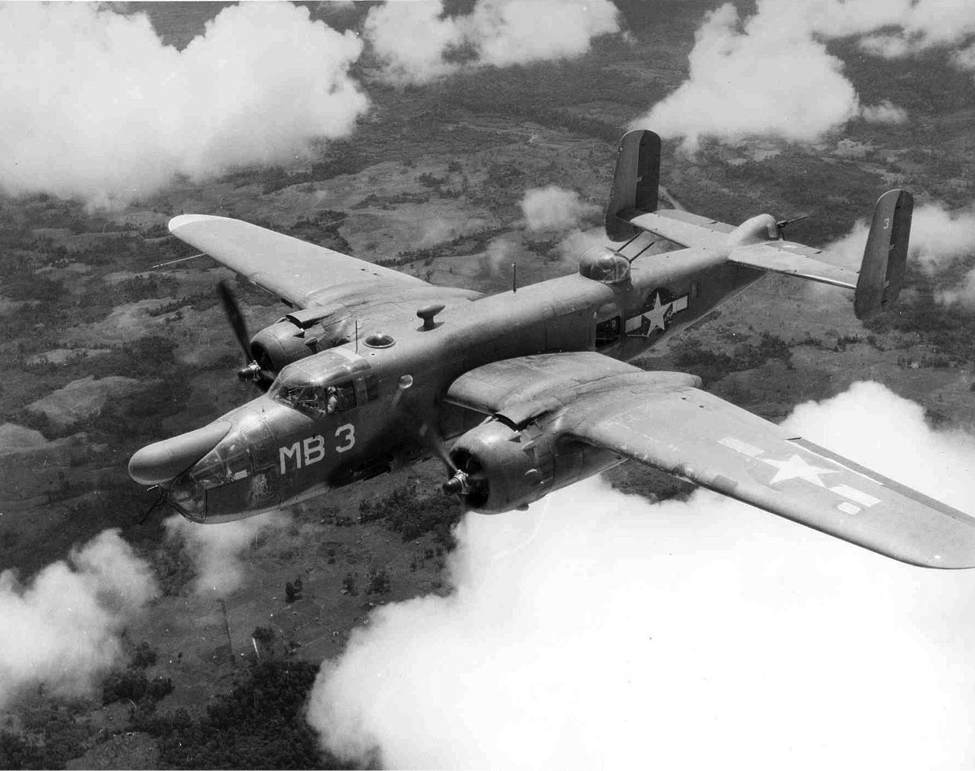There Were Several Good Medium Bombers But North American’s B-25 Was the Best
On 11 April 1939, the North American NA-40B, NX14221, took off from Wright Field in Ohio to undertake a series of engine-out tests. During one of those tests, the pilot lost control of the aircraft, which crashed.
The subsequent fire consumed the aircraft, but the crew escaped serious injury. As a result, Douglas won the 1937 competition with its design, which would become the A-20 Boston/Havoc. North American Aviation (NAA) went back to the drawing board.
The lessons learned with the NA-40B were incorporated into a new twin-engine bomber design, which NAA designated the NA-62. Today, we know that aircraft as the B-25 Mitchell medium bomber.
Competition With the Marauder
The NA-62 design was entered into the 1939 United States Army Air Corps (USAAC) medium bomber competition. Competing against the NA-62 was the Martin B-26 Marauder. Although there was no B-25 prototype aircraft yet, the USAAC ordered the NA-62 design into production as the B-25. The Marauder was also ordered into production without a single flyable example available for inspection, meaning both designs were essentially ordered right off the drawing board. The 9,816 B-25s produced by NAA would go on to serve with nearly every allied nation and in every theatre of World War II, train thousands of Air Force multi-engine pilots and crew members, and even star in a few movies.
Keeping The Best Out in Front
Distinctive design features of the B-25 were the twin vertical stabilizers mounted at the ends of the horizontal stabilizer in the tail of the aircraft and the pronounced “gull” wing, which resulted from the outer wing panels being designed with anhedral, or downward angle, from the engine nacelles out to the wingtips.
B-25s were continuously improved, modified, and upgraded throughout the design’s history, resulting in 28 distinct variants with differing primary mission capabilities, armor and armament configurations, inclusion of self-sealing fuel tanks, nose and tail gun installations, and dorsal (upper fuselage) gun turret locations. When used by the United States Navy (USN) or Marine Corps (USMC), the B-25 was designated PBJ.
The B-25 Mitchell Packed a Wallop
Early production variants of the B-25 Mitchell were used for the famous raid on Tokyo by Doolittle and his raiders. B-25Cs were employed against Japanese targets in the Pacific beginning early in 1942 and continuing for the rest of the war. It was found that bombing from the medium altitudes at which the B-25 was designed and intended to bomb was less effective than low-level tactics.
When 5th Air Force weaponeer Paul “Pappy” Gunn field-installed six forward-firing .50 caliber machine guns in their noses at the Townsville Modification Depot in Australia, and then loaded them full of parachute-retarded fragmentary bombs (parafrags), the modified 5th Air Force B-25Cs and B-25Ds became highly effective low-level strafing skip-bombers.
The coming out party for these “commerce raiders” was the Battle of the Bismarck Sea. Gunn and his team removed the Bendix remote-controlled ventral turret from many of these bombers. The crews considered it useless to begin with, and after all, who needs a belly turret when you do all your flying down in the weeds anyway?

The Flying Cannon
NAA incorporated some of the field mods that Gunn and his weaponeers made into the B-25G and B-25H models. The G had a shorter nose, two 50-caliber machine guns, and a 75-millimeter M4 cannon.
The M4 was the largest cannon used on production aircraft during the war. The G model also eliminated the ventral turret, added two defensive gunnery positions in the fuselage aft of the wings (the “waist” positions), and improved the tail gunner position. On the H model B-25, the M4 cannon was replaced by a lighter-weight built-for-purpose cannon, and more .50 caliber machine guns were added up front.
Due to its slow rate of fire and substantial recoil, the 75-millimeter cannon was removed from many of the G and H models and replaced with additional .50-caliber machine guns. The B-25H also did not have a copilot or bombardier. The pilot shared space under the greenhouse with the combination navigator/cannoneer who loaded the 75-millimeter cannon.
The dorsal turret was moved forward to offset the extra crew and weapon weight now carried aft in the waist and tail of the bomber. The ability to carry up to eight 5″ high velocity aerial rockets (HVARs) on rails under the outer wing panels was also incorporated.





A guy named Joe
Always (based on A Guy Named Joe)
My first flight as a young airman two striper was in a B-25 “hack” in 1956 from Griffiss to Stewart in New York. I sat on a bench just behind the pilots and directly in line with the propeller tips just inches beyond the skin of the ship. It was a very loud hour long trip. Pretty cool, though.
The SF B-movie “THEM!”
The doctors from Washington arrive in a B25
In the B Movie, The Claw”, the generals who were in command of the military response to a large alien bird terrorizing air and ground transportation, used a stripped-down B-25 with a cannon mounted in the tail to shoot “atomic fireballs” at the bird’s protective shield as it tried to catch the plane. Then, it used wing mounted rockets to kill it.
A B-25 was part of the story in No Time for Sergeants. The aircraft was being flown by Will Hutchins (later Sugarfoot) and Jamie Farr (MASH) with Nick Adams (The Rebel) and Andy Griffith as crew. I encountered Mr. Farr once as we waited to depart Little Rock Regional Airport, and I remarked about his appearance in this film. He said, “wow, that was before I was in the army”. He probably expected that I would ask about his part in MASH.
I lost interest reading this when the author describes the B-25 “Gull Wing” as having an anhedral angle. This is incorrect. The outer wing panels are mounted at zero degrees dihedral/anhedral. Because the inner wing panels are mounted with a dihedral the appearance is of a “gull wing” but it is strictly appearance. FWIW, the first 10 B-25’s, including “Miss Hap” which still flies, were constructed with a consistent dihedral from root to tip but later modified with the outer wing at a zero angle when shown to improve stability and handling.
A B-25 also appeared in “633 Squadron”.
I didn’t think it was possible to auger in and walk away with serious injury
My Uncle who was an Air Force pilot in WWII told me one of his experiences was ferrying B25’s to Fairbanks Alaska where they were then turned over to the Russians who wanted them for tank busters against the Germans. He was career Air Force and finished in the NSA.
How about 1992’s Forever Young, Mel Gibson is a B-25 pilot.
My dad flew B-25’s in the S Pacific in WWII. He had a engine blown off the mounts over Rabaul. They had no hydraulics or radios and flew back to Sterling Island and made a single engine gear up flaps up landing on the Japanese dirt strip. He was the only one injured as his L ear drum was ruptured when the Pom Pom shell hit the L Engine. Dad was loosing altitude and had the CE and a gunner opened the bomb doors with a crank, loosened the shackles an kicked loose the 4, 250 pound bombs with VT fuses set at 50 feet. 1LT Scruggs was awarded the Distinguished Flying Cross.